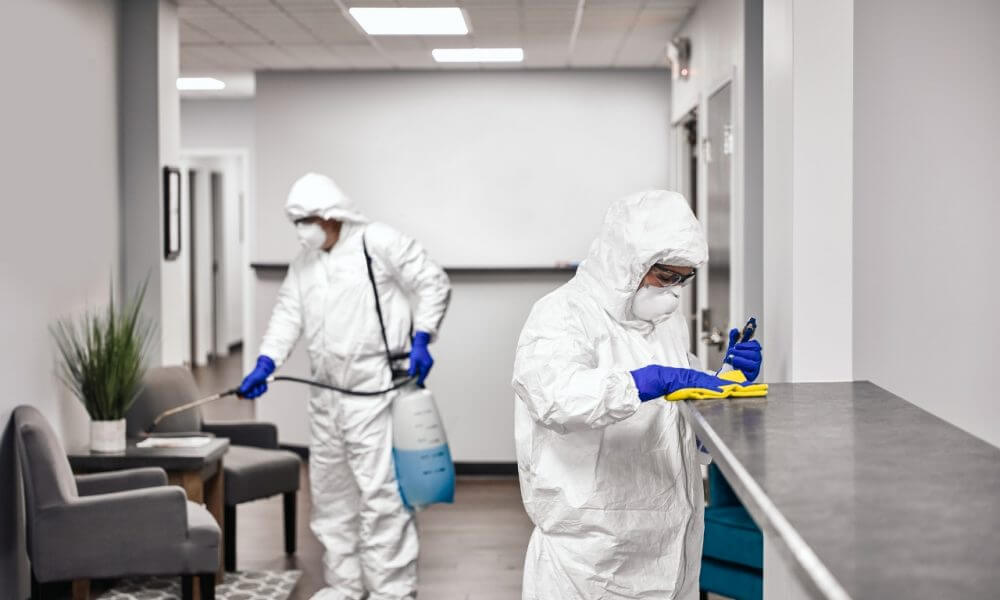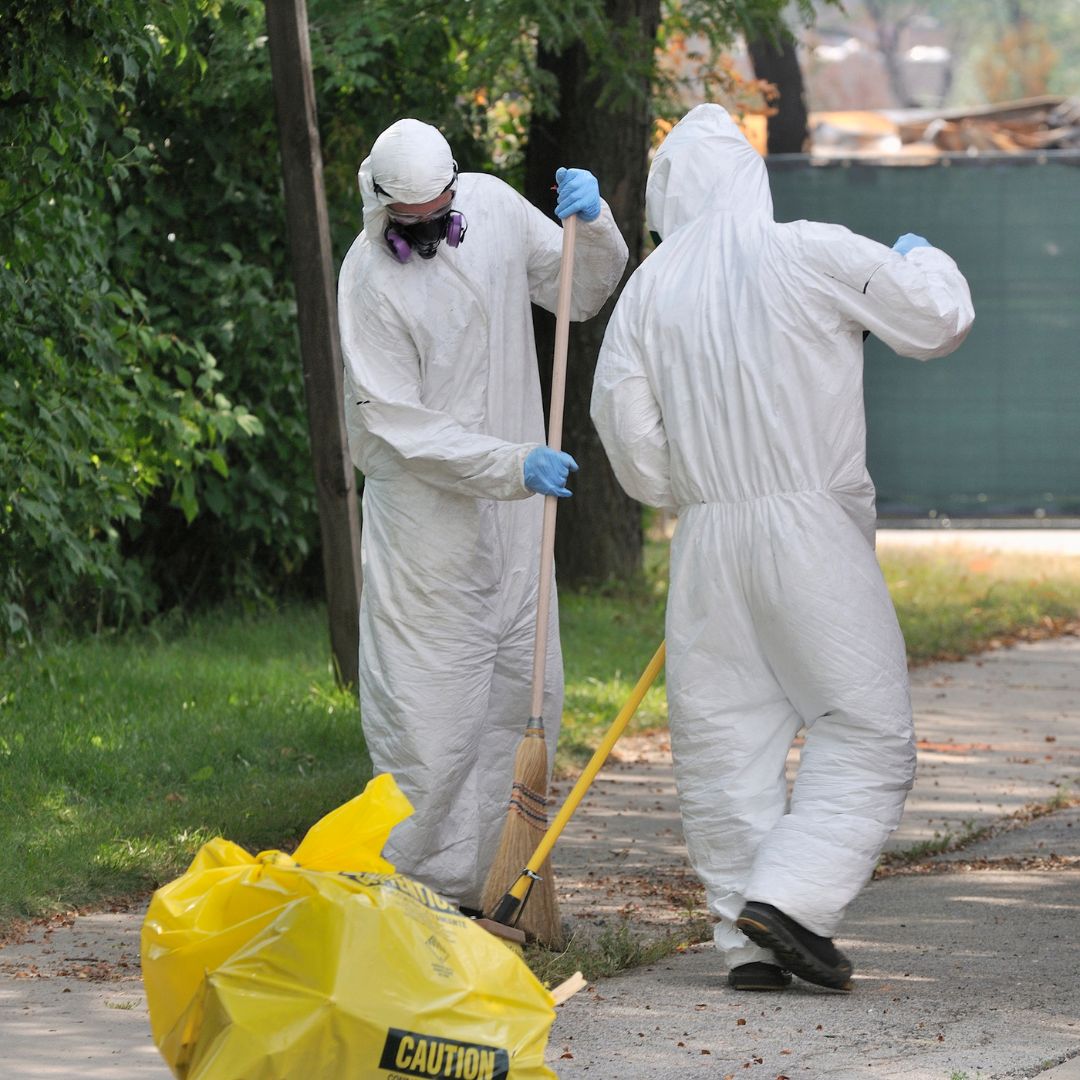Decomposition Death Clean Up: Specialized and Respectful Remediation
Decomposition Death Clean Up: Specialized and Respectful Remediation
Blog Article
Expert Biohazard Cleaning and Purification for Blood, Bodily Fluids, and Hazardous Materials
The potential wellness risks connected with direct exposure to biohazards underscore the essential need for precise handling and detailed cleanup. As we navigate the complex landscape of biohazard cleaning, understanding the nuances of guidelines, conformity, and the customized equipment at play becomes imperative in guaranteeing a comprehensive and risk-free purification procedure.
Wellness Threats of Biohazard Exposure
Direct exposure to biohazards positions considerable health and wellness dangers that can cause serious repercussions for individuals and neighborhoods alike. Biohazards incorporate a wide variety of organic materials, consisting of blood, physical liquids, mold and mildew, germs, viruses, and various other possibly transmittable products. When people come right into contact with these biohazards, whether with mishaps, improper handling, or environmental exposure, they deal with the risk of contracting severe health problems or illness.
Among the primary wellness threats related to biohazard exposure is the transmission of transmittable conditions. Bloodborne virus such as HIV, hepatitis B and C, and various bacteria can be existing in biohazardous products, presenting a direct risk to human health and wellness. Inhaling air-borne biohazards like mold and mildew spores or entering contact with contaminated surface areas can likewise result in respiratory concerns, allergic reactions, and other adverse wellness impacts.
Additionally, biohazard direct exposure can have long-lasting health effects, with some diseases manifesting years after the first get in touch with (Blood Cleanup). Therefore, it is critical to prioritize proper biohazard cleansing and decontamination to minimize these health and wellness threats and ensure the safety and security of individuals and areas

Specialized Training for Biohazard Cleanup
When it involves managing biohazard clean-up efficiently and securely, specialized training plays a basic role in making sure correct decontamination treatments are adhered to. Biohazard cleaning requires particular understanding and abilities to properly mitigate risks related to bloodborne microorganisms, physical liquids, and unsafe products. Professionals trained in biohazard cleanup undergo extensive guideline on just how to securely take care of, eliminate, and dispose of biohazardous products to prevent contamination and exposure.
Specialized training for biohazard clean-up covers a variety of essential subjects, consisting of appropriate personal protective tools (PPE) use, bloodborne virus awareness, decontamination methods, and harmful waste disposal methods. People learnt biohazard clean-up are furnished with the required competence to assess contamination levels, recognize possible dangers, and carry out suitable cleanup treatments in conformity with regulative standards.
Continuous training and education are paramount in the field of biohazard cleaning to remain updated on the latest purification innovations, safety protocols, and laws. By investing in specialized training, biohazard cleanup professionals can efficiently reply to emergency clean-up scenarios and secure both public health and wellness and the setting.
Value of Proper Purification Methods
Making use of appropriate purification methods is crucial in biohazard cleaning to efficiently remove dangerous products and reduce health and wellness risks. Efficient purification not only ensures the elimination of visible traces of blood, physical fluids, and various other biohazards but likewise targets unnoticeable pathogens that might present serious wellness risks otherwise properly removed. By complying with rigid purification protocols, trained specialists can considerably minimize the risk of exposure to hazardous microbes, viruses, and bacteria that might result in diseases or infections.
Proper decontamination methods entail the use of specialized devices and anti-bacterials that are especially designed to neutralize biohazards efficiently. Complete cleaning and sanitation of infected areas are vital to protect against the spread of virus and ensure a safe environment for residents. Furthermore, the right disposal of biohazardous waste following purification treatments is vital in stopping contamination of various other surface areas or people.

Devices and Tools for Safe Cleaning
The appropriate tools and tools play a critical function in guaranteeing the efficient and safe cleaning of biohazardous products. When taking care of blood, physical liquids, or harmful materials, biohazard cleaning professionals rely on specialized gear to minimize exposure threats and completely sanitize the afflicted location. Personal safety equipment (PPE) such as handwear covers, coveralls, goggles, and masks are necessary to secure versus direct call with potentially transmittable materials. In addition, biohazard cleaning sets containing disinfectants, absorbing materials, and biohazard bags are utilized to securely get rid of and contain of polluted items. Blood Cleanup.
Advanced cleansing devices like hospital-grade disinfectants, HEPA-filtered vacuums, and fogging makers are used to disinfect surface areas and remove biohazards properly. Specialized equipment such as sharps containers and biohazard waste disposal bins are utilized to safely handle sharp items and biohazardous waste materials. By using the ideal tools and devices, biohazard cleansing specialists can make certain a thorough cleanup process that prioritizes safety and security and decreases wellness dangers for both employees and residents of the afflicted room.
Regulations and Compliance in Biohazard Cleansing
Appropriate adherence to guidelines and conformity requirements is critical in biohazard cleaning to make sure the security of both workers Read Full Article and the environment. Government firms such as OSHA (Occupational Security and Wellness Administration) and the EPA (Environmental Security Company) have actually established details standards for biohazard cleanup treatments to minimize health dangers and ecological contamination. These laws cover an array of aspects including the handling, transportation, and disposal of biohazardous materials, in addition to the required training and protective tools required for workers included in the cleanup procedure.
Biohazard cleansing firms have to remain current with these laws to assure that their procedures fulfill the required security standards. Failing to abide by these laws can lead to serious repercussions, consisting of fines, lawsuit, and endangering the health and wellness of people and the setting. By adhering to rigid guidelines and conformity procedures, biohazard cleaning companies can effectively reduce threats and guarantee a safe and complete cleanup procedure for all parties included.
Verdict
Finally, biohazard cleansing and decontamination need customized training, appropriate techniques, and adherence to guidelines. Direct exposure to blood, bodily liquids, and harmful materials presents substantial health dangers, making it critical to use the best tools and devices for safe cleanup. By complying with rigorous methods and standards, specialists can efficiently mitigate the risks related to biohazard direct exposure and guarantee the safety and security of both themselves and others.
As we navigate the detailed landscape of biohazard clean-up, understanding the nuances of policies, conformity, and the specialized equipment at play ends up being important in ensuring a complete and risk-free decontamination procedure. (Blood visit this site right here Cleanup)
When it comes to handling biohazard cleaning effectively and securely, specialized training plays a basic duty in making certain proper purification procedures are followed.Making use of correct decontamination strategies is crucial in biohazard clean-up to effectively lessen and get rid of harmful materials health threats. In addition, biohazard cleansing kits containing disinfectants, absorbing products, and biohazard bags are used to safely dispose and contain of infected products.
Government agencies such as OSHA (Occupational Safety And Security and Health Administration) and the EPA (Environmental Protection Firm) have Get More Information developed certain guidelines for biohazard cleaning procedures to minimize wellness threats and ecological contamination.
Report this page